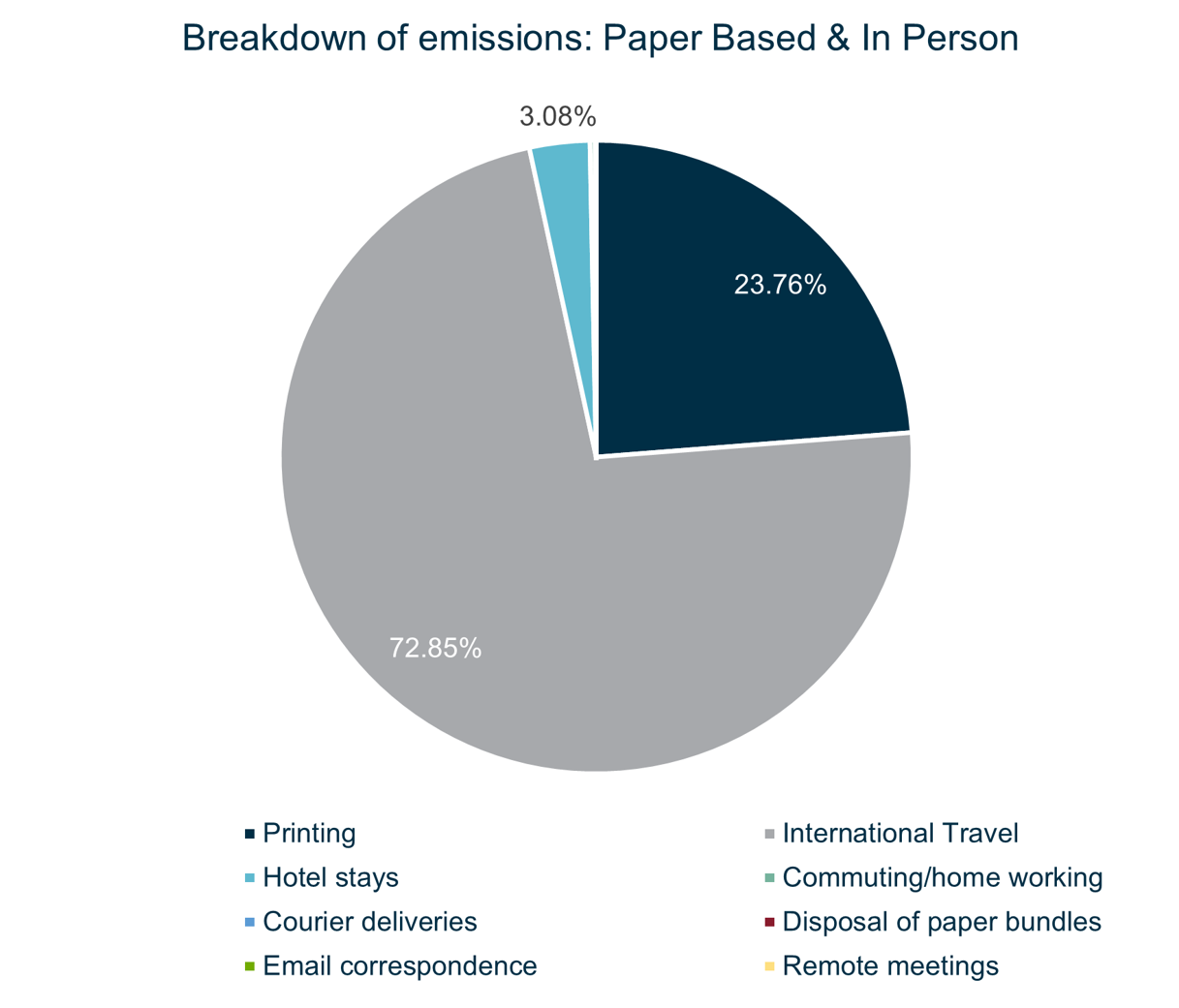Flying the flag for greener international litigation
Published on 16th October 2023

Case study illustrates impact of remote hearings on reducing carbon emissions
Twelve months ago Osborne Clarke became a signatory to the Greener Litigation Pledge, a mission statement setting out practical changes for litigators to make in the journey towards net zero. We have conducted a case study to illustrate how changes in the way a case is run can have a profound effect on its carbon footprint.
This is relevant to all clients conducting litigation with their own net zero goals.
Comparison of a typical international litigation case: in person vs remote
We conducted an analysis of a typical litigation case, from pre-action pleadings, through disclosure, to trial to illustrate how the environmental impacts can add up.
In our scenario, there were four witnesses, three experts, a one-day Case Management Conference and half a day of Pre-Trial Review. The trial itself lasted five weeks. We calculated the emissions that would arise when conducting the case fully in-person (with experts and witnesses flying between a European city (we used Rome for our calculations) and London and staying in hotels overnight when necessary), adding the element of printed hard copy bundles at each stage. We compared this with the emissions associated with conducting the case remotely, with the only international travel being at the trial stage, and all evidence submitted electronically (which we believe reflects the reality of modern commercial litigation).
The results were striking. The in-person case clocked up 14.4 tonnes CO2e, more than seven times the emissions of the online case, which had a footprint of 1.9 tonnes CO2e. A considerable 73% of that impact came from the travel: 24 return flights in total, with UK rail transfers, adding up to 10.52 tonnes.

Figure 1: Bar chart showing the emissions sources in our two scenarios
Unsurprisingly, the impact of the printing of paper bundles, with the assumption that new bundles would be required for each stage of the litigation process, was not inconsiderable either. Bundles accounted for 24% of the emissions in the in-person scenario, with a further small amount coming from their disposal via confidential waste (shredding and recycling).

Figure 2: Pie chart showing the breakdown of emissions in the in-person case
In the online case, 93% of the emissions were associated with flights undertaken for a hybrid hearing. Had we looked at a fully remote trial, with no international travel at all, emissions would have been 0.14 tonnes CO2e – less than a one hundredth of the footprint of the in-person case.
Ultimately, the decision as to whether a trial will be fully remote or not rests with the judiciary. Although the Business and Property Courts have the technological means to run trials fully remotely, there are many reasons why parties and the courts prefer evidence to be given in person. Anecdotally, it seems that many judges still prefer to see witness evidence given "live", in order to assess the credibility of such evidence. There is also the added complication that a party wishing to have witnesses give evidence remotely may need the permission from the local courts or authorities first and this can take some time to obtain (and is not a given, either – for example, in a recent decision, the UK foreign office objection to an application to allow witnesses to give evidence remotely, because the German government had stated that it would not allow German nationals to give evidence by video in the courts of other countries).
Assumptions and omissions
We wanted our scenarios to be realistic examples of a typical litigation case, and in order to calculate these emissions footprints a number of assumptions were made:
- All meetings and witness proofing sessions would last five hours
- Witnesses would fly economy class from Rome to London Heathrow, a journey of 1,446km, and then transfer to central London via the Elizabeth Line (23km). The impact of the return leg of the flight was also calculated, but the onward journey from Rome airport was not.
- Each bundle would comprise 400 sheets of virgin A4 paper, 80gsm. We estimated that 130 separate copies of the bundle would be produced over the full course of the trial.
- A batch of bundles would be couriered by taxi from our offices to the courts, a journey of one mile
- An electronic bundle of this size would take up 5MB of data
- In the online scenario, we still factored in four return flights assuming that the hearing would be hybrid, with remote observation.
In the interests of focusing on what we believe to be the material differences, we also excluded some aspects from the calculations. Background emissions associated with keeping courts and offices running (heating, lighting and other utilities) were not factored in to either scenario, and for simplicity we excluded "well to tank" emissions associated with travel. While we worked out the carbon impact of the rail transfers between central London and Heathrow, we did not do the same for the Italian side of the journey, in either scenario. Finally, we also omitted any emissions associated with archiving one of the bundles after the trial. Data for this is not readily available and it was deemed negligible in the overall context of the case.
Impact of international travel
As any business that reports on Scope 3 (other indirect) emissions will know, business travel can make up a significant proportion of an organisation's carbon footprint, particularly in the professional services sector. For example, at Osborne Clarke it is the third largest category of our emissions, behind Purchased Goods and Services and Capital Goods, and larger than emissions from our energy consumption (Scope 1 and 2 combined).
Choices around modes of transport are important. According to the Department for Environment, Food and Rural Affairs, a domestic flight within the UK accounts for seven times more emissions per kilometre than a standard rail journey, while a short haul flight from the UK to Europe accounts for 34 times more emissions per kilometre than an international rail journey. This rises to 50 times more if the flight is Business Class. While transport infrastructure is decarbonising year on year, it is clear that businesses must consider the impact of travel policies and behaviours, and work together to overcome barriers to change, to realise emissions goals.
Osborne Clarke comment
The Greener Litigation Pledge includes a number of actions that law firms (and affiliate members) should take to minimise the environmental impact of our practice. Several of these actions, including electronic correspondence are already the norm for law firms. Many are also committing to using low carbon forms of travel and purchasing energy from renewable sources, as part of Science Based Targets or other climate action plans.
There are some aspects of the pledge which are more difficult for individual signatories to achieve, requiring a more collaborative effort. Decisions around where and how litigation action is conducted are ultimately made by the court. The reasons for those decisions can be complex, but the outcomes can have a significant impact on emissions for all parties involved.
Sector-wide initiatives like the Greener Litigation Pledge give businesses valuable opportunities to collaborate and leverage their influence to grow the net zero movement. This case study will hopefully lend weight to requests for remote trials (where appropriate): decisions about the conduct of trials can be shown to have a real impact on the environment.
Osborne Clarke's Sustainability and Reporting Manager, Mary Lavin, compiled the research.



